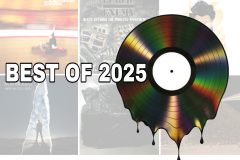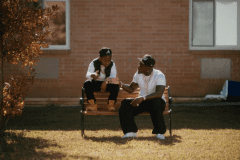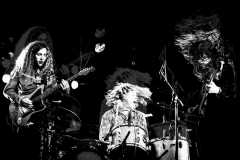Marc Ribot will release Map of a Blue City (New West Records) on May 23, 2025. The 9-song set was produced and mixed by Ben Greenberg based on original studio sessions produced by Hal Willner, as well as home recordings. Most renowned as a wildly inventive guitarist who has collaborated with Tom Waits, Elvis Costello, John Zorn, Wilson Pickett, Marianne Faithfull, Caetano Veloso, Solomon Burke, Robert Plant & Alison Krauss, Neko Case, among many, many others, Map of a Blue City features Ribot’s imaginative playing and leads to what may be his definitive statement as an instrumentalist, as a songwriter, and even as a singer. While it’s not a traditional singer-songwriter album, it is his first to center his plaintive, wise voice quite so prominently throughout. Map of a Blue City showcases songs colliding disparate traditions: roots, bossa nova, no wave, noise, free jazz, and sounds that have no genre associations. Mostly featuring original compositions, the collection includes Ribot’s rendition of the Carter Family’s “When the World’s on Fire” as well as his treatment of Allen Ginsberg’s 1949 poem, “Sometime Jailhouse Blues.”
Today, Ribot released his version of “When the World’s on Fire.” His rendition of the traditional brings its lyrics into a contemporary landscape in which apocalyptic prophecies have become daily headlines. He says, “The Carter Family recorded this song in 1930. You have to admit they were way ahead of the curve. I added a few lyrics to make it safe for agnostics.”
Marc Ribot has been living with Map of a Blue City for nearly thirty years. He wrote some of the songs in the 1990s and made home recordings that were all the more intimate and immediate for being so lo-fi. He sent this first version to a label, but was told it was “too dark.” Other projects demanded his attention, but he never really abandoned the album. The songs just wouldn’t leave him alone. He says, “I just had an affection for them, so I never forgot about them. I wasn’t working on them constantly, but every once in a while I would take another lunge at finishing them.
In 2014 he attempted to recapture that vibe in a professional studio with his old friend, the legendary producer Hal Willner, with whom he’d worked on countless projects—including the 1989 Allen Ginsberg album The Lion for Real. “Hal of course did a great job. But it became a very big deal with strings and other great musicians. But at the end of it all, I liked my demos better, so we shelved the project again for a while.” They spoke once or twice about revisiting the songs, but Willner died in 2020 (Ribot wrote of the loss in his 2021 memoir, Unstrung: Rants and Stories of a Noise Guitarist: “It’s like waking up and finding the Empire State Building gone.”) He didn’t want to start over with these songs, but wasn’t sure how to move forward. He was, appropriately, lost, until meeting Greenberg, producer and guitarist for the Brooklyn industrial band Uniform (and early member of The Men). “I didn’t know how I could reconcile the stuff I’d recorded with Willner with the home recordings that I felt were the heart of the record…whether I could make everything fit on the same record, but Ben is a total genius. We added some overdubs, but we also took a lot of stuff away, too… Amazingly, it worked!”
Map of a Blue City ruminates on what it means to be lost—the confusion and fear, of course, but also the excitement of so many undreamt-of possibilities. Its history is an odd map of its own, full of false starts, blind alleys, and dead ends. The album bears the weight of its history gracefully, incorporating recordings made over nearly half of his life and reflecting on how he got to this particular moment. “Working on this album for so long, I’ve seen the world change dramatically and not really change at all. Some of the issues today are the same ones I thought about when I was just starting the album, but some are things I couldn’t have dreamt of at the time. But I think that’s why I was so determined to get the production values right. Recording production is really complicated, but it all boils down to what kind of room the listener feels they’re standing in. There are some hard truths and cold observations in these songs. I wanted the room to be small enough so that we couldn’t turn away; but warm enough to feel like you’re hearing it from a friend.”
Solo Guitar / Improv – May European Tour:
May 9 – La Bisbal, Spain – Teatre Mundial
May 10 – Madrid, Spain – Recoletos Jazz Madrid
May 11 – Koln, Germany – Stadtgarten. Europäisches Zentrum für Jazz und Aktuelle Musik
May 12 – Oberhausen, Germany – Ebertbad
May 14 – Barcelos, Portugal – Theatro Gil Vicente
May 16 – Fribourg, Switzerland – La Spirale
May 17 – London, UK – Cafe Oto
May 18 – London, UK – Cafe Oto
May 20 – Vicenza, Italy – Teatro Comunale Città di Vicenza
May 21 – Budapest, Hungary – House of Music Hungary
May 23 – Plauen, Germany – Malzhaus
May 25 – Bergen, Norway – Sardinen USF Verftet
Marc Ribot: Map of a Blue City:
June 11 – Brooklyn, NY – Roulette (Record Release Show)
With Ceramic Dog:
June 22 – Ottawa, Canada Ottawa Jazz Festival
June 25 – Albany, NY The Egg +Map of a Blue City (opening set)
June 26 – Montreal/CA Montreal Jazz Festival
Marc Ribot Quartet: Hurry Red Telephone
(w/Ava Mendoza, Sebastian Steinberg, Chad Taylor)
July 16 – London, UK – Jazz Cafe
Jazzaldia 60 Festival Residency:
July 25-27 – San Sebastian, Spain – Residency at Jazzaldia 60 Festival
July 25 – Marc Ribot Quartet: Hurry Red Telephone
July 26 – Solo
July 27 – Ceramic Dog








Social Media